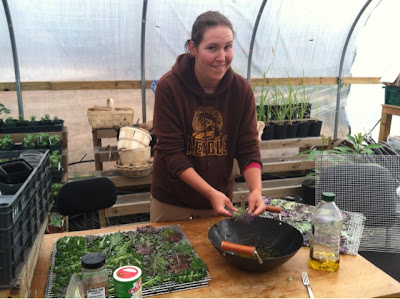If there was a magic wand in the culinary world to turn the vegetable-indifferent into fiends for leafy greens, it would be kale chips.
How generous of the kale plant, already packed with calcium, iron and vitamin A, to become a crispy, lip-smacking treat with the simple addition of olive oil, a few seasonings and heat. No one can resist the power of the kale chip - even those who turn up their nose at carrot sticks and salad greens.
Hannah and I have snacked on kale chips from our oven many a time prior to cycling cross-country, but we hadn't considered its potential as a dried food source that could help power us down the road. The summer and fall before we took off, we dried apples and onions, fruit leather and tomatoes, preserving the bounty of the farm and packing it into boxes to be mailed to us along our route, providing relief from the deep-fried diet of the southern tier.
Kale seemed too abundant, too common a vegetable to deserve our time and postage, but at our recent volunteer stint at Coldwater Gardens in west Florida, we realized that it is the perfect lightweight and nutritionally loaded food for the long-distance cyclist.
It was a rainy afternoon and the rest of the volunteers were crowded into the greenhouse planting seeds. Unable to resist the call of the shiny food dehydrator and the luxurious beds of kale waiting to be picked, I enlisted Hannah's help and went chip-crazy. There is no "recipe" but procedure is important, so read on to DIY.
Note: For those who don't have access to a garden full of kale already, you'll find it reasonably priced at just about any farmer's market ($2.50 or so for a good-sized bundle). It's also easy to grow yourself year-round. (Hint: In hot climates, kale makes a better winter crop. Or you might be able to grow it in a shady spot or construct one using burlap or a shade cloth. If kale gets too hot it will attract aphids.)
Step 1: Pick your kale. Italian or Dinosaur Kale (the variety with flat, rounded leaves) lays nice and flat and tends to be less brittle when chipped. On the other hand, we really enjoy the flavor of Red Russian (the purply, frilly leaves) and don't mind ending up with a thousand fragments of kale all over our faces when we eat it. Go for nice, big leaves and chop off any long stems.
Step 2: Remove excess moisture. If you're making kale chips on a rainy day, as we did, or if you choose to rinse the leaves before consuming (use your best judgement), the water droplets will interfere with your kale's ability to absorb the all-important olive oil. You can either pat it dry with clean kitchen towels or spread it on your cookie sheets or dehydrator racks and put it in the oven/dehydrator until the water evaporates off. Use the oven's lowest temperature to avoid crisping the kale prematurely.
Step 3: Season. This is where we get creative. Mix olive oil with soy sauce or salt, plus onion or garlic powder, pepper. More fun additions are paprika, nutritional yeast, powdered ginger or cayenne. Now the trick is to lightly coat the leaves. Best technique is to dip your fingers into the mixture and massage it onto each leaf. That way you can control the amount of both the seasonings and the oil. If your leaf is dripping, it'll turn out too greasy. If you only sprinkle it, the edges will burn or just dry out and lose their flavor.
Step 4: Apply heat. In the food dehydrator, we dried the leaves for about 3 1/2 hours at 135 degrees Fahrenheit. In the oven, 15-20 minutes at 350 will do it, flipping the leaves halfway through.
Step 5: Consume immediately or store. Florida is about as humid as it gets, so we enlisted the help of the other Coldwater Gardens workers to eliminate a large pile of kale chips as soon as they came out of the dehydrator. Then we used a vacuum sealer to make convenient snack-packs out of the rest. At home, where the air is slightly less saturated with moisture, kale chips will last a day or so in a ziploc bag before getting soggy. But really, you're better off finding an unsuspecting vegetable-hater to consume the rest.
Ten days later: Our vacuum-sealed kale chips didn't stay crispy, but we found a multitude of uses for them. We crumbled them into scrambled eggs and snuck them into sandwiches. If it weren't so darned hot, they would be great in soup or some sort of cheesy pasta thing. Kale in our bellies, we pedaled eastward, closing in the end of the southern tier route. Have salt and calcium, will travel!





No comments:
Post a Comment